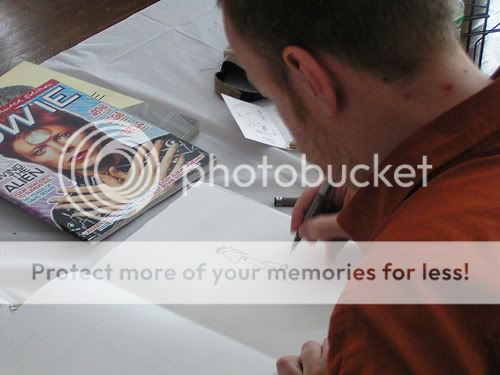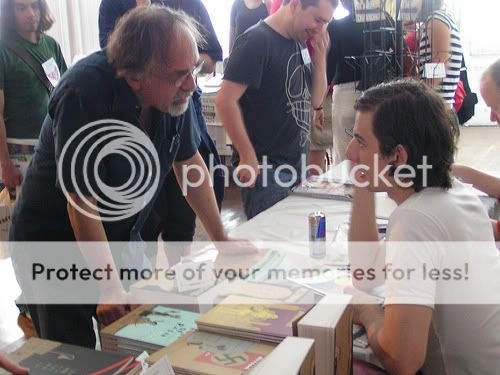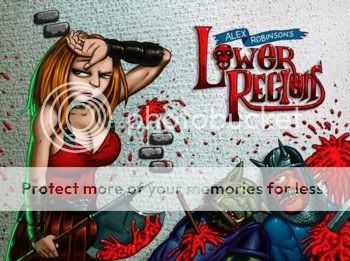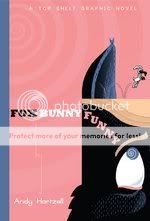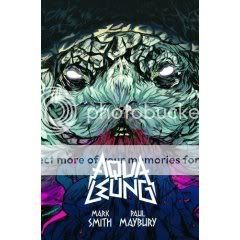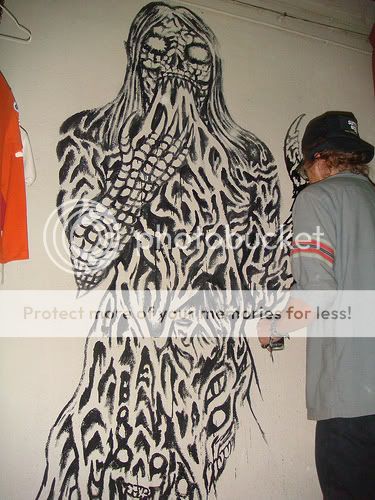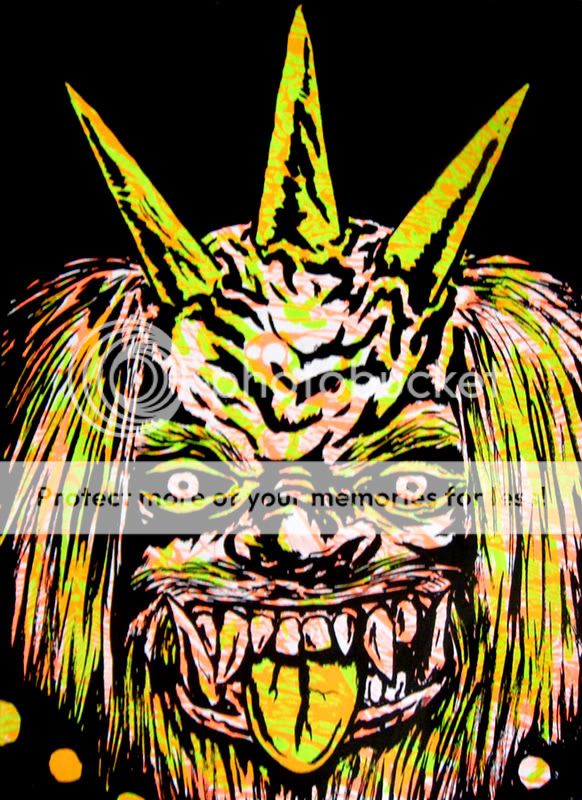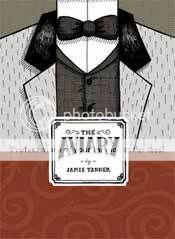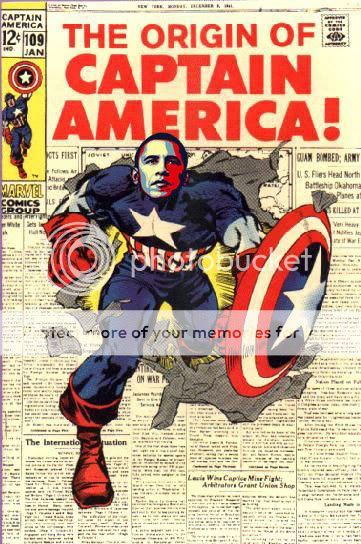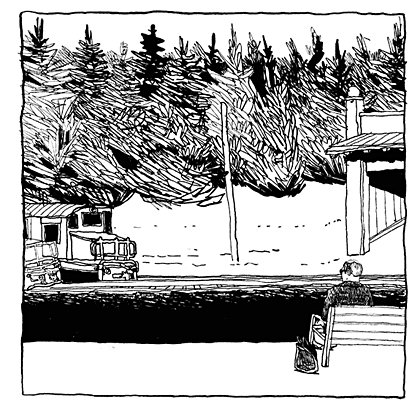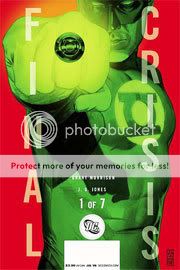Archive for June 16, 2008
Carnival of souls
June 16, 2008* The big news of the day is that Stan Winston has died. Winston contributed make-up and special effects to some of the most iconic films of the past thirty-odd years of fantastic fiction, including The Terminator and Terminator 2, Predator, Aliens, The Monster Squad, The Thing, Jurassic Park, Iron Man and more. He was the most influential visualizer of horror this side of Jack Pierce and Ray Harryhausen. He’ll be deeply missed.
* Look, it’s the David Bowie sketchbook in action!
That’s Jason adding his contribution up top, and me (the person who isn’t Art Spiegelman or Dash Shaw) watching him do so down below. Via Mike Baehr at Fantagraphics and his MoCCA report.
* David Lynch talks to The Atlantic about where he gets his ideas, advancing the theory that they exist fully formed prior to his conceptualizing them and he merely catches them like a fisherman catches fish. If there is an artist who displays a bigger contrast between demeanor and creative output than Lynch, I have yet to encounter him. (Via Matthew Yglesias.)
* Jon Hastings apparently loved The Happening. So many people hated it that I’d be here all day rattling off links even just to people whose work I already like, but the first one I came across is BC of Horror Movie a Day. I hope to see it this weekend.
* Also from the “reviews of films I haven’t seen” files, here’s an absolutely enthralling roundtable discussion of…Krull? Oddly enough for someone who was as big a He-Man fan as I was, I never got into the sword-and-sorcery flicks of the early ’80s. This is probably because I was also a huge scaredy-cat. I do remember some well-meaning family member renting Beastmaster for me, and I started bawling uncontrollably when it looked like some sorcerer person was going to make some pregnant lady’s belly pop and they had to stop the movie.
* Here’s a review of a movie I actually have seen: My own review of The Incredible Hulk.
* Want to hear My Bloody Valentine’s first gig in over 15 years? (Via Pitchfork, who have pictures if you’ve been swoonily daydreaming about how Kevin Shields and/or Bilinda Butcher look these days.)
* Finally, your quote of the day comes from an episode of the BBC music special Sounding Out from (I’m assuming) 1972:
Every time you go to a gig, you have a cursory look at the audience, but you know what it’s gonna be like. They’re always, to a man, gonna be between 16 and 20, the young, white, affluent kids of the particular town you’re in. They’re all gonna have long hair. They’re all gonna have slightly tattier clothes than they need to wear.
–Bill Bruford, drummer, Yes. Plus ça change…
Hulk smash
June 16, 2008I feel like I’ve taken an inordinate amount of guff for looking forward to The Incredible Hulk. For starters I’ve been mercilessly taunted by the “Ed Norton is a prima donna artsy-fartsy asshole who should just shut up and make movies” brigade. Then there’s the “nobody cares about this movie, Iron Man has all the buzz, it’s the hippest happenin’est superhero movie around baby” fanboy-EW-wannabe contingent. And lately I’ve even got into it with a small army of people who prescribe to the absurd notion that Jennifer Connelly is more attractive than Liv Tyler. (The hell you say!) And oh yeah, some people just think it’s a mediocre movie.
Well ha ha ha ha ha, you’re all wrong! The Incredible Hulk was basically exactly what I was looking for in a Hulk movie. Three rock-solid action sequences that made tremendous use of their physical settings (the chase through the Brazilian urban sprawl was particularly stunning), with the consequences for the combatants easily parseable amid the CGI rubble. Terrifically vulnerable leads in Edward Norton and Liv Tyler–the former imbuing Bruce Banner’s every move with a sort of hangdog desperation that his life as a human being with anything to offer anyone is over, the latter using her breathy voice and just-wept eyes and lips to convey the awkwardness of running into someone you used to love as well as you’re gonna see in a movie. Moments of memorable, borderline-poetic action spectacle that more than make up for seeing the seams of the SFX–the savagery of the Hulk vs. Abomination fight is as strong as anything from the second and third Spider-Man films, which had some excellent, beautiful fights despite their other flaws.
Then there were little surprises–the sneak-attack emergence of the Mr. Blue character as a bit of a mad scientist, which really snuck up as organically as possible in a big Hollywood blockbuster. Moments of glamor and wit, like Tyler’s sultry tossing and turning, Norton’s weird breathing exercises, and the very funny “we can’t have sex or I’ll Hulk out mid-coitus” moment. And the biggest twist of all: The fact that this was more or less an Abomination origin movie, showing us Emil Blonsky’s journey from black-ops badass at the top of his game to a first-time loser obsessed with his defeat, at which point, enter superhero pseudoscience. That’s your superhero-movie origin structure in a nutshell, and here it’s used on background to cook up the antagonist. Clever!
I’m quite glad I saw it in a theater full of cheering, clapping people, in midtown New York City, at 5 o’clock on a Monday. It was a hoot, as good in its way as Iron Man, with those characters’ cleverness replaced by these characters’ awkwardness. It works.
Comics Time: Alex Robinson’s Lower Regions
June 16, 2008Alex Robinson’s Lower Regions
Alex Robinson, writer/artist
Top Shelf, October 2007
56 pages
$6.95
The kind of comic for which the phrase “your mileage may vary” was invented, Lower Regions (its official title; I went with the long version above to preserve the obvious pun) is Alex Robinson’s loving tribute to the pulp-Tolkien fantasy hodgepodge of the Dungeons & Dragons games of his youth. As such I really enjoyed it. I didn’t play D&D as a kid, mind you–not until after my freshman year in college, and then only for one glorious, Sam Adams-soaked summer–but as an avid Tolkien reader since kindergarten and a He-Man action-figure fan extraordinaire, I kind of get the D&D aesthetic through osmosis via its antecedent and offspring. Robinson develops an impressive assortment of monsters and thugs for his pneumatic barbarian heroine to bloodily dispatch, throwing in the buckets of gore and hint of gratuitous, seedy sex/nudity that was a big unspoken part of the attraction of the earthier brands of heroic fantasy for nerdy adolescents. (What’s up, Xanth?) The comic is wordless, as these kinds of things tend to be, and if that means that the action choreography and (particularly) the attempts at conveying thought or speech are occasionally muddled, well, you really only have to get through a page or two max before you come to the next axe getting lobbed at an ogre’s head. Robinson’s goofy character designs, which have kept me away from his straightforward comics, obviously work quite well here. I’d say that the opening image of a band of goons and creatures led by some kind of sexy topless demon-priestess will tell you all you need to know about whether you’ll enjoy the rest of the book.
It’s not the side effects of the cocaine…
June 14, 2008…I’m thinking that it must be the Thin White Sketchbook, Part 3!
Last weekend was the MoCCA Art Festival 2008, and me and my David Bowie sketchbook (previously seen here and here) were back in action. As always, I couldn’t be more pleased with the results.
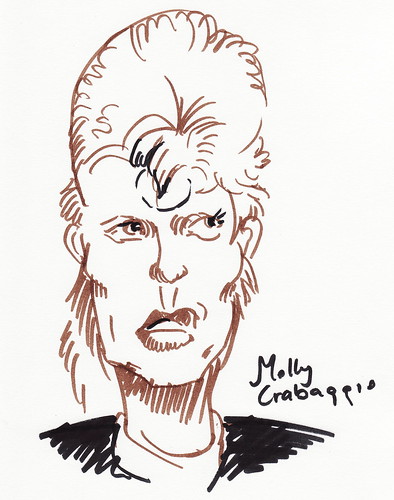
Molly Crabapple: Eyes to the skies and halfway between classy and goofy, as is the wont of Molly’s dandies.
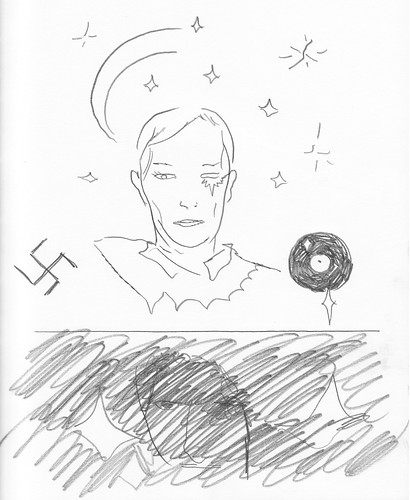
CF: CF seemed excited to draw Bowie, until he flipped through my sketchbook, which he said was intimidating. He handed this back, saying “He was a great Nazi sympathizer.” That’s something of a misrepresentation, as a matter of fact–and something of a disconcerting addition to the sketchbook–but one does not look gift sketches in the mouth, I suppose.
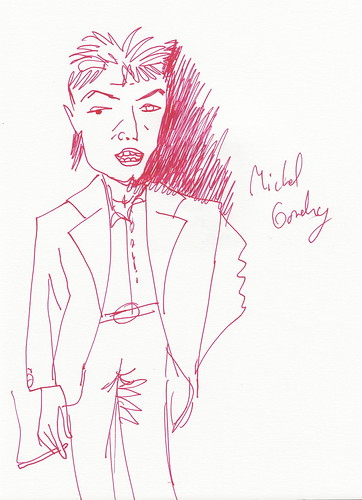
Michel Gondry: Yes, that Michel Gondry. The fact that I have a sketch of David Bowie by the man who directed the video for “Everlong” is pretty goddamn wonderful if you ask me. Gondry insisted I buy his comic book in exchange for the sketch, which seems fair.
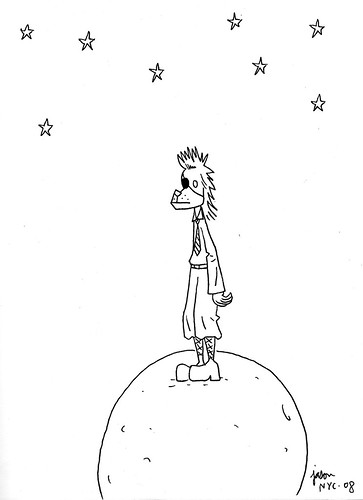
Jason: The most underappreciated cartoonist around, given his talent, Jason commanded huge sketch/autograph lines at the show. He actually apologized for “getting the clothes wrong” on this, but Bowie as an anthropomorphized doggie version of The Little Prince? No apology necessary.
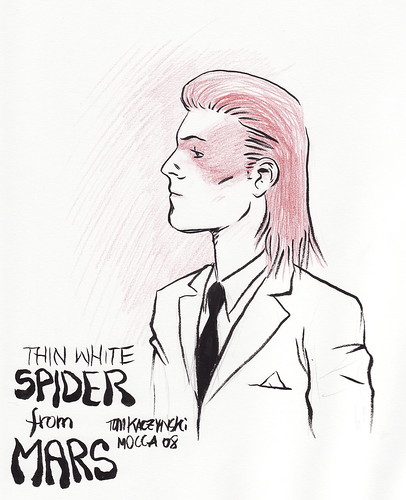
Tom Kaczynski: A mash-up of Bowie’s two most stylish eras. My favorite sketch of the show. Look at that luscious red!
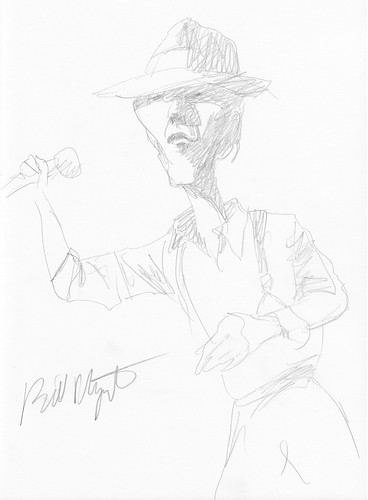
Bill Plympton: Yes, that Bill Plympton. When I saw this animation legend’s name on the guest list for the show, I got pretty excited. It paid off.
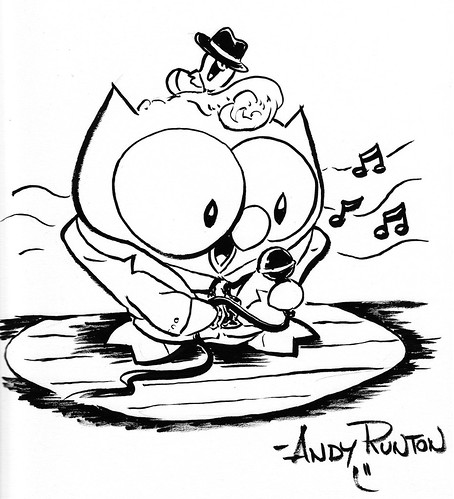
Andy Runton: Runton draws his trademark character Owly as any other character you like. He went for one of Bowie’s well-dressed crooner phases for me. Compare and contrast with the CF, if you will.

Dash Shaw: I get kind of a silent-movie expressionist vibe from this one, don’t you?

Kazimir Strzepek: This shot of Bowie, based on his soldier-boy look from the film Just a Gigolo, looks like it could have come right from one of Kaz’s post-apocalyptic fantasies.
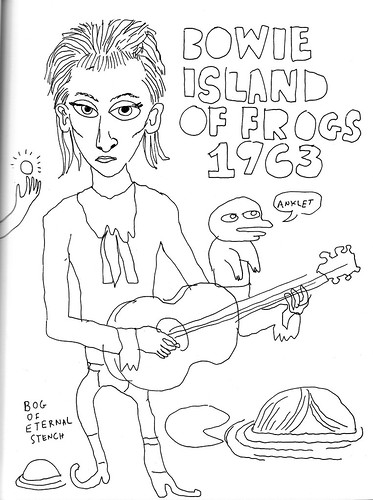
Matthew Thurber: Thurber made a pretty wild Bowie minicomic called What Kind of Magic Spell to Use, an alternate-reality take on the recording of the Labyrinth soundtrack with producer Steve Albini (!). Needless to say he was a must-get on my list.
Don’t forget to check out the sketches I got at MoCCA 2007 and SPX 2007, or see the whole shebang as a Flickr set. Drink to the men (and women) who draw sketches for you and I! Drink, drink, drain your glass, raise your glass high!
Carnival of souls
June 13, 2008* Shock Till You Drop reports that Ryuhei Kitamura’s adaptation of Clive Barker’s Midnight Meat Train will receive a limited 100-theater release. So much for The Strangers saving R-rated horror, eh wot?
* SPOILERY Descent/Descent 2 tidbits ahoy: The entire cast of the original Descent will be returning in The Descent 2 via flashback. (Via Bloody Disgusting.) So yes, the new film will pick up where the American cut of the first film left off. Since I find being haunted by guilt and failure for the rest of your life to be a more disturbing source of fear than remaining stuck in a cave full of creatures trying to eat you, I’ve always prefered the U.S. version to the U.K. version, so this news makes me pretty happy.
* At least one of those rumored Battlestar Galactica TV movies looks like a going concern for this year, while the show’s Sopranos-style “final season part deux” may pick up an additional 2 hours to go from 10 to 12, according to the Chicago Tribune’s Maureen Ryan. I’d have been marginally more excited about this news before the current half-season, but hey, I hear tonight’s episode is a real mind-blower. We’ll see. (Via Jason Adams.)
* I enjoyed Keith Uhlich’s essay on the new four-film Rambo DVD box set a great deal, because I think in comparing John Rambo varyingly to Frankenstein’s monster, Tintin, and the Hercules of Greek myth he gets at the heart of the character: Rambo is war. He’s offensive, heroic, and disturbing, easy to harness to propagandaiacal aims yet always too strange, complex, and dangerous to stay harnessed. (Via The House Next Door.)
* The Groovy Age of Horror’s Curt Purcell continues his examination of supernatural horror with a second critique of Freud’s “The Uncanny,” this one focusing on Freud’s (mis?)interpretation of his key source, E.T.A. Hoffman’s “The Sand-Man.”
* Your quote of the day comes from Jim Henley, discussing recent witch hunts in Kenya:
A working definition of “witch” has long been “a widow with some property.”
* Finally, just a friendly reminder that you can buy my comic book Murder for the low low price of three American dollars at the Partyka shop.
Comics Time: Paradise Kiss Vols. 1-5
June 13, 2008Paradise Kiss Vols. 1-5
Ai Yazawa, writer/artist
Tokyopop, 2002-2004
Approx. 180 pages each
$9.99 each
Originally written on September 28th, 2004 for publication in The Comics Journal
I never really understood the notion of style (as opposed to fashion) until the lead singer of the Dandy Warhols explained it to me. Courtney Taylor-Taylor, the ectomorphic frontman for the Portland-based purveyors of retro-decadent glam pop, told me during an interview that style is merely the outward manifestation of a person’s insides. “How should my clothes fit and how should my hair look [is determined by] which look for me will better represent, at first glance, what I am about,” he said. (A fringe benefit, he later added, was that this acted as a filter against meeting people who don’t already like you, so you end up involved in fewer dead-end conversations.)
Coming as it did at a point in my life where I was in the throes of an obsession with David Bowie, Roxy Music, Velvet Goldmine, and the entire glitter aesthetic (one which continues to this day), Taylor-Taylor’s words were a revelation to me. Though a combination of poverty and laziness has kept me from perfecting the type of personality-in-wardrobe-form the rock star was advocating, I continue to applaud those with the creativity and willpower to make a go of it.
It’s undoubtedly this reverence for style, combined with a comics fan’s appreciation for a unique story well told, a singular artistic sensibility, and stories about and for teenagers that condescend to neither character nor reader, that leads me to dig Paradise Kiss. Published by manga giant Tokyopop and prepared for the English-language audience by a bevy of translators and adaptors, Parakiss (to crib a familiar abbreviation the characters themselves use when referring to both the clothing design studio around which the comic centers and, in regular breakings of the fourth wall, the comic itself) is a pip of a series, five volumes of angst, lust, and fabulous, fabulous clothes.
Yazawa’s art serves as a wonderful descriptor of all three. Fans of the McCloudian notion that art and story are indistinguishable in comics will find much to love here, since (to these relatively inexperienced eyes) the graphic conventions of shoujo manga (the razor-thin line against acres of white backgrounds, the effete, wire-thin figures, even the riot of pseudo-dialogue and untranslated sound effects peppered throughout translated works) are for once harnessed to a story that makes sense out of them. When studious and beautiful prep-schooler Yukari gets drawn into the world of four students at a high school for the arts, Yazawa’s intricate and ornate draftsmanship does effective double duty, skillfully capturing not only the sensuous and emotional confusion our heroine feels as her world changes, but the gorgeous, Velvet Goldmine-quoting boy (George) who seduces her, and the exquisite, anachronistic clothes he designs.
Those clothes are a highlight, undoubtedly; I found myself looking forward to each chapter’s title page, since those pages boast pin-up images of Yukari (“Caroline,” to her Anglophilic new friends) and the rest of the crew in painstakingly drawn couture. Such moments also pop up in the narrative as well, as during the climactic fashion show, which is lovely enough from both a graphic and storytelling point of view that it ably bears the four volumes’ worth of weight placed upon it. In all cases it’s evidence that the apparent frivolity of Yazawa’s art is icing on a cake that’s not just substantive, but no less delicious for it.
The same can be said of her writing. We’re largely in teen soap territory here, but that’s undercut with a surprising deftness in characterization, brutal at times (George’s attention-starved ex-model mother, George himself in his egocentricity and sexual predation) and unexpectedly warm at others (gruff punk Arashi’s unechoed concern at the way Yukari is ditching her previous life more or less on a whim, young George’s gift to his budding drag-queen friend Isabella). There’s also a sexual frankness that’s quite refreshing: Sex is treated neither as an idealized pathway to spiritual perfection nor as a sweaty and sordid means of disease transmission, but as something that can be a great deal of fun and, therefore, a great deal of trouble. When Yukari walks in on her new friends Miwako and Arashi fucking on a pool table because neither of them has any privacy in their bedrooms, early in the first volume, I’m sure I’m not the only reader who thought “yep, that’s about right.” (The fact that the scenes are so opulently drawn reminds us, to paraphrase Trainspotting, that if it weren’t so pleasurable we wouldn’t do it.)
If anything, it’s this fidelity to the actual experience of teenage sexuality and gender issues that can be off-putting. At no point does Yukari (or Miwako), seem to think of her own pleasure as paramount when it comes to sex; the act is typically initiated either through pressure (in one alluded-to incident, physical) or as a surefire way to change a painful subject, and is always seen through the lens of the boy involved–how it makes him feel, about the relationship, about her; how she feels about the relationship, about him. Of course, I’ve seen little evidence that this unfortunate state of sexual affairs for Yukari is not indicative of how nearly all teenage girls are conditioned to view sex, so perhaps Yazawa is to be applauded for telling it like it is rather than chided for not setting a better example. Ditto her portrayal of Yukari’s entrée into the world of professional modeling–the poor girl is chided on several occasions to stop eating so much, a scene that will make the eating disordered in the book’s audience either cringe in horror or chuckle in recognition. (Speaking of that audience, how cool is it to read a comic book that assumes its reader is a girl? And one in which beautiful male characters are paraded around as eye candy and objects of the gaze?) Moreover, high school may suck, and we all wanted to escape from it, but if you’re a girl looking for freedom from conformity, stricture and misogyny, the fashion industry is not exactly a place I’d advise you to run to. Then again, all the characters seem to gain some awareness of this art-cum-industry’s faults, particularly in the book’s unusually nuanced epilogue, so it’s not like Parakiss is peddling the same line of bullshit as Cosmopolitan.
In other words, Paradise Kiss is about style, not fashion, despite its industry trappings (and despite appearing in serialized format in a Japanese fashion magazine). For George, Yukari, and the rest of the Paradise Kiss studio, the clothes are never about riding the crest of a trend or obeying external expectations–despite the fact that their success as designers (and as people) would be far more likely if that were the case. The clothes are about representing, at first glance, what they as young men and women (and drag queens) are all about. A bunch of precocious, horny, fucked-up 17-year-olds may not know what they’re all about, of course, but maybe that’s what makes their sense of style, and this manga, so enthralling.
Notes on two series
June 12, 2008I finished Death Note the other day, and wow. I had no idea a comic book could be that thrilling and suspenseful! Nothing was off limits, no one was safe, and because of that the suspense sequences were viscerally, physically exciting, as much so as any movie. The car chase, the hideout siege, the moment-to-moment final showdowns between Kira and his antagonists–I was tearing through the pages and cheering and gasping like I don’t think I’ve ever done with a comic before. Well done, Ohba and Obata.
I’m five episodes into the final season of Deadwood, and…I almost don’t know what to say. So I probably am not going to say much of anything until I can sit and think of an entry point to talking about the series. It’s moving and magnificent on an episode to episode basis, that’s for sure. Today I watched a scene and at the end of it I had an enormous headache, and I suddenly realized I’d literally been holding my breath. Blown away.
It’s making me a lot less impressed with The goddamn Wire, too.
Carnival of souls
June 11, 2008* Apparently, Marvel may have decided they don’t need Jon Favreau for Iron Man 2. Favreau himself says they haven’t even gotten in touch with him about it yet. That’s pretty stupid of Marvel. Perhaps the outcry all over the Internerd will shame them into bringing him back.
* FourFour’s Rich Juzwiak pays photographic tribute to Anton Corbijn’s biopic of Joy Division lead singer Ian Curtis, Control. Unforgivable that I still haven’t seen this, I know.
* I’ve been waiting for the right time to link to Karl Kerschl’s lovely webcomic about a mute Sasquatch/Yeti and his misadventures in a forest, The Abominable Charles Christopher, and today’s installment seems like the right time:
Comics Time: Fox Bunny Funny
June 11, 2008Fox Bunny Funny
Andy Hartzell, writer/artist
Top Shelf, June 2007
106 pages
$10
This very good funny-animal comic stands out from the anthropomorphized pack because its visual metaphor strengthens the impact of its more outrageous moments rather than diluting it. Anyone can get some mawkish sentimentality out of casting a cuddly critter in their tale of modern urban ennui, or flip the script and go for some guffaws by doing the umpteenth Fritz the Cat mammals-with-mammaries sex farce. Hartzell aims elsewhere in Fox Bunny Funny.
The first highlight is the violence. We meet our fox protagonist as an awkward adolescent in a broadly drawn conformist suburbia of sitcom vintage, where his fellow foxes kill and consume bunnies with gusto. When our hero is discovered hopping around behind closed doors wearing a bunny costume (I’ve gotten caught doing worse), he’s shipped off to a fox-scout camp where he’s trained to use an impressively horrible beartrap-shooting weapon on bunny-shaped bullseyes. When he proves an excellent marksman, his scoutmaster drags him along on a bona-fide hunt…to the town where the bunnies live with all the same civilizational niceities as the foxes. Hartzell depicts their rampage with disturbing imaginativeness–the foxes run bunnies in cars off bridges, plow through restaurants in their SUV, then smash their way into a bunny family’s home, burst in on their Anne Frank attic hideout, and slaughter them. Eventually the hero flees to a bunny church (the suffering of the bunnies analogized to the suffering of Christ), but when he’s discovered frolicking with the congregation by his fellow scouts, he can’t take the pressure and leads the slaughter himself. Obviously, making both predators and prey into human-style civilizations heightens the savagery of the foxes’ attacks on the bunnies. It may be a metaphor for war or racism or meat-eating or all three at once; mostly it comes across as a refreshingly harsh indictment of human brutality and stupidity in all its forms.
The second strong point is the depiction of a shared fox-bunny counterculture. After the murder in the church, we join our hero years later, where he’s a perfectly normal member of the bunny-eating masses. When a bunny prankster attacks his house, he’s led on a chase through the proverbial and literal rabbit hole into a West-Village-meets-Haight/Ashbury urban freak mecca, where bunnies and rabbits of all genders mix and mingle enthusiastically. Hartzell saves some of his most exciting cartooning for this sequence, including a Where’s Waldo/Hard Boiled-style two-page spread of the scene. What’s special here is that comics, particularly alternative comics, takes the existence of a counterculture for granted. Hartzell sets up the structure of Fox Bunny Funny in such a way that the discovery of this counterculture feels like a legitimate revelation. Do you remember when you were younger, and you first started pursuing countercultural interests and hanging out with the freaks or ‘bangers or emo kids or skaters or whatever they were where you grew up, or first journeyed to a big city and saw that people could be weird or gay and not be looked at like zoo animals for it, and this simple fact felt like both an explosion of self-liberation and a massive “fuck you” rebuke to society at large? Hartzell nails that. And then he goes one step weirder and more asseritve with the conclusion. All with impeccable, wordless kids’-book cartooning. I think I love this comic.
Carnival of souls
June 10, 2008* Here at ADDTF I enjoy taking credit for being right, since it happens so infrequently. Regular readers may note that I’ve been defending The Incredible Hulk against sight-unseen unfavorable comparisons to Iron Man and kvetching about the supposedly prima-donnaish behavior of star Edward Norton for months now. So I feel some vindication in reading my friend Zach Oat’s rave review of the movie at Television Without Pity and good ol’ Harry Knowles’s report that Norton is, in fact, doing press for the film (in roughly the same capacity he’s done so for most of his other movies). Speaking of, here’s a roundtable interview between Norton, director Louis Leterrier, and soul-crushingly pretty co-star Liv Tyler at Moviefone. I bet you I like this movie.
* Fun fact I learned from Zach’s review: Lou Ferrigno voices the Hulk in the movie! Fun fact I learned from the roundtable interview: The RZA was on set! Fun fact I learned from the roundtable interview number two: Liv Tyler knows Gizmo’s little song from Gremlins by heart! (Even if she calls the movie Goonies.)
* Grant Morrison’s implied suggestion that fans with beef over the continuity blips in his Final Crisis #1 should be so kind as to sit on it and rotate went over like gangbusters with me, but some other folks are more skeptical. Tom Spurgeon says it’s unfair to fault fans conditioned for functional continuity to expect it, while in a lively comment thread on thishyere blog Jim Treacher argues that by working on a story completely dependent on continuity and then rejecting pleas for said continuity, Morrison’s trying to have it both ways. Sean of the late, lamented Strange Ink and Bruce Baugh weigh in with counterarguments in that same thread.
* In other Morrison news, Big Sunny D (!!!) muses on the Mad Scot’s oddly absorbing Batman run.
* At Wizard’s Indie Jones blog, my compadre David Paggi posts his MoCCA report (with photos), and ends it with a phrase I never thought I’d hear uttered by anyone who didn’t grow up on my block during the ’80s.
* The New York Times reports that nine inch nails’ Trent Reznor is indeed planning a TV series based on his dystopian concept album year zero with producer Lawrence Bender. (Via Pitchfork.)
* In the “interesting-looking reviews of films I haven’t seen yet,” CRwM of And Now the Screaming Starts takes a look at blogosphere favorite Inside.
* Curt Purcell of The Groovy Age of Horror continues his exploration of supernatural horror with an in-depth examination of the linguistic underpinnings of Freud’s conception of the Uncanny.
* A multitude of my League of Tana Tea Drinkers horrorblogging compatriots tackle Evil Children in horror.
Murder for hire
June 10, 2008My comic book Murder is now available for purchase at the Partyka shop for the bargain price of $3.

Carnival of souls
June 9, 2008* I recommend Joe “Jog” McCulloch’s MoCCA report.
* I do not recommend reading Platinum Dunes producer Brad Fuller’s rationale for remaking Rosemary’s Baby:
“I want to address that,” Fuller said. “Because if we don’t do Rosemary’s Baby, somebody else [will]. They’re not going to pass on it. And, like I said, being horror fans like we are, we would want to take the opportunity and take a shot at it, rather than read about someone else doing it. So all the s–t we get for doing these things–it really just comes out of being huge fans and wanting to take a shot, you know?”
Fuller added that they have not come up with a story for the reboot of Rosemary.
This line of reasoning in almost beautiful in its utter lack of cluefulness on every level. But don’t worry, everyone, “it really just comes out of being huge fans.” See, he’s one of us, my fellow idiots horror buffs! (Via the equally appalled Jason Adams.)
* Here’s a very, very, very long examination of the final scene in The Sopranos that makes a fairly convincing case for interpreting it in one particular direction rather than another. It goes in for close-reading that borders on clue-spotting, but that is by no means the sole source of its argument–the most convincing aspects are the ones drawn from a series of increasingly less cryptic statements I’d never heard before from creator David Chase. (Via Keith Uhlich.)
* This interview with Grant Morrison about Final Crisis #1 is, as they say, FULL OF WIN. In large part the questioner, Newsarama’s Matt Brady, focuses on continuity discrepancies between FC #1 and various miniseries from the past year or so, particularly the widely rejected weekly “spine of the DC Universe” series Countdown. Morrison’s answers, which explain that most of the events we’ve seen so far that contradict what happened in his comic were written after his was completed, are beyond delightful:
Obviously, I would have preferred it if the New Gods hadn’’t been spotlighted at all, let alone quite so intensively before I got a chance to bring them back but I don’t run DC and don’t make the decisions as to how and where the characters are deployed.
[snip]
…bear in mind that Countdown only finished last month so Final Crisis was already well underway long before Countdown and although I’ve tried to avoid contradicting much of the twists and turns of that book as I can with the current Final Crisis scripts, the truth is, we were too far down the road of our own book to reflect everything that went on in Countdown, hence the disconnects that online commentators, sadly, seem to find more fascinating than the stories themselves.
[snip]
The way I see it readers can choose to spend the rest of the year fixating on the plot quirks of a series which has ended, or they can breathe a sight of relief, settle back and enjoy the shiny new DC universe status quo we’re setting up in the pages of Final Crisis and its satellite books. I’m sure both of these paths to enlightenment will find adherents of different temperaments.
I don’t know why this particular interview is reducing me to Internerd speak, but that’s just pwnage all over the place. It also scratches a real itch for me because I’ve spent most of the time since the issue came out debating with some friends of mine whether or not Grant “should” have tweaked a line or two to “fix” the “problems” of his comic not lining up with Jimmy Palmiotti & Justin Gray’s or whoever it was that did the New Gods stuff in Countdown. Even aside from the temporal/logistical issues Morrison himself points out, the answer is “of course not.” He’s a writer, not a janitor, and his obligation is to tell a good story, not to provide a seamless experience for devotees of a shared fictional universe cobbled together from the work of thousands of disparate creators by corporate diktat.
Anyway, the interview also explains how the issue connects with similar elements in Seven Soldiers, sticks the book into Identity Crisis a bit, and confirms my theory as to why the book took an offhand approach to Martian Manhunter’s death:
we wanted to open with a nasty, execution-style death of a superhero as a way of demonstrating how far behind us the Silver Age is. We’re conditioned to expect the hero to fall after a noble struggle or to give his life saving the universe but this had to be different. The scene was very much about calling time on expectations and letting our readers know up front that the rules have changed. Evil is getting away with it. Things are going to get nastier and grubbier and scarier before it’s over, just like in the real world.
I look forward to subsequent issues.
Comics Time: Aqua Leung Vol. 1
June 9, 2008Aqua Leung Vol. 1
Mark Smith, writer
Paul Maybury, artist
Image, April 2008
208 pages
$17.99
Here’s a book you can’t help but compare to other, similar projects that are mining this same vein of ad-hoc epic and homegrown myth(os)-making. Consider it the “A Star Wars of One’s Own” school. (I’ve dabbled in it myself.) The book I kept thinking of when reading it is Mouse Guard. This one comes out on top in virtually every way.
First of all it’s the rare independent comic that comes equipped with not one but two editors, including one seemingly solely dedicated to copyediting. And man, does it help! The story is a coming-of-age hero quest that frequently indulges in knowingly arcane dialogue, and it’s really easy to aim for “fancy” and end up hitting “gibberish.” This doesn’t happen here, which is a blessing right there.
Second, there’s Paul Maybury’s art. Don’t get me wrong, I think Mouse Guard‘s Mark Peterson is obviously a gifted illustrator, and also a better sequential artist than he perhaps might get credit for. But Maybury is something of a revelation here, his thick brush line (apparently this is his first-ever brush art!) at different times approximating the Paul Pope-Becky Cloonan art-blob vibe, the more manga-inflected Vasilis Lolos punk-action thing, some Bryan Lee O’Malley-isms in the character designs, and–out of left field–almost Fort Thunder-ish use of images-as-texture (a wall of “STOMP” sound effects, a two-page spread of arrows, a splash page consisting solely of clashing colors, and an opening map that looks like Ron Rege drew it), occasionally peeling back to an effectively crude, almost childlike minimalism. Colorist Russ Lowery is a break-out star here too, combining Lolos’s candy-coated palette with Dave Stewart’s subtlety and lushness. Smith’s script gives the pair plenty of room to play, with almost abstract combat scenes and bravura sequences like the Spaceball One-sized sea-monster whose jaws take fully four pages to traverse our viewpoint.
Speaking of Smith, he brings a most welcome sense of humor about the grandiose nature of this project to the table, something Mouse Guard lacks entirely. Will you wish he hadn’t kept The Hero with a Thousand Faces next to his laptop as he wrote this story? Sometimes, yeah. (Enough with the fucking absent father figures already, genre writers of America!) At first the epic saga-osity of the material gets the better of him–he burdens the story with something like four introductory sequences, and lets an omniscient narrator tell things that should be shown early on. But the structure smoothes out as the book goes on. Meanwhile he frequently undercuts any portentousness with a wink and a nod to his diverse sources, from the inclusion of a little octopus sidekick that feels like something out of a Japan-only video game to shots of the titular young hero peeking up girls’ skirts, flashback-sequence from Splash-style. And the approach to the violence is more Indiana Jones than Star Wars, if that makes sense–while it does move the plot and is supposed to inspire the awe of any good action sequence, it also unfolds like a choreographed routine and draws attention to that fact. What’s more, he sticks the landing with a climactic battle that feels climactic yet also naturally subservient to whatever will happen in the subsequent volumes.
Overall there’s really nothing here that leaves you feeling like everyone involve needs to get out of their parents’ basement in some fundamental way–it feels like grown-ups knowingly playing with their old action figures more than grown-ups trying to pretend that those action figures are for grown-ups. Nor does it mistake the modest aim of telling the story of its creators dreams for the delusional grandeur of Telling The Story Of Our Collective Unconscious. And oh yeah, the lettering and logo by Fonografiks is really kinda perfectly METAL. I even like the paper and cover stock. It’s a good time.
Carnival of souls
June 8, 2008* Not everyone who gets stranded on a deserted island winds up on one with Elizabeth Mitchell on it. No, some folks–like five divers who got swept 20 miles away from their boat by the current and had to seek shelter on the Indonesian isle of Rinca–wash up on a beach where they get attacked by a Komodo dragon. Try to imagine spending hours adrift at sea, desperately swimming to the first land you can find, then looking up and finding a dinosaur is chasing you. (Via Tim F.)
* A new batch reminds me that stills from Midnight Meat Train are always pretty. I’ve got high hopes for this film and it’ll be a shame if the release is uber-limited or otherwise botched.
* Go, look: Mat Brinkman in the studio! (Via Monster Brains.) At MoCCA this weekend my table was directly across from PictureBox, and they had these killer Mat Brinkman pieces that stared me in the face all weekend long, silently tempting me to buy them despite how they’d probably go over when presented to the relevant persons as decorations for my new house.
* Finally, does anyone have a problem viewing this blog in terms of the body column being too wide so you have to scroll right to read each sentence, in Explorer or any other browser? Please email me if so.
Carnival of souls
June 7, 2008* The creators of The Wire have apparently decided to make a show that’s even easier for the writers of sociocultural thinkpieces to wax enthusiastic about and are adapting the nonfiction Iraq War book Generation Kill as an HBO miniseries. AICN’s review sums up the team’s, uh, appeal:
As you know, Ed Burns and David Simon were the writers/creators/producers of HBO’s “The Wire.” In my opinion, “The Wire” is hands-down the best show ever made. Period. End of discussion. Sure, I love “The Sopranos,” “Lost,” the Whedonverse, and several other TV staples, but what makes “The Wire” excel above all the rest, is its journalistic approach to filmmaking. Simon and Burns use TV, as a writer uses a notepad. No flash or bombast. No overreaching character arcs designed to bludgeon you to death with their profundity. They’re intent is not to entertain, but to inform.
Swell.
* Kristin Thompson will be attending San Diego Comic Con. To participate in a Hobbit movie panel. The Film Studies 101 student in me just can not get over this.
* CRwM gives the business to mainstream critics who feel it’s their solemn duty to Speak Truth to Genre.
* Finally, I just want everyone looking to keep cool tomorrow from 11am to 6pm to know that my table at MoCCA, in same corner as PictureBox and Pantheon, is perhaps the most air-conditioned place in the New York metro area. Just sayin’.
Comics Time: The Aviary
June 6, 2008The Aviary
Jamie Tanner, writer/artist
AdHouse, June 2007
312 pages
$12.95
I was challenged and intrigued by the idea of, and the ideas in, this debut graphic novel, comprising various interlocking minicomic and anthology strips. “The Aviary,” as we slowly come to realize, is a term for a strange, insular city peopled by various subconsciously resonant weirdos: an art-porn impresario who is also an anthropomorphized monkey, a sexy but viciously nasty receptionist, a limbless stand-up comedian, and so on. Popping up throughout is a blinking bird-headed doll/automaton called the Silent Bird-Man, alternately a symbol of reproachful authority and libidinous secrecy. Some clever shifts in the temporal order of the events being presented lead to a mobius-strip vibe reminiscent of one of David Lynch’s psychogenic fugue films; yes, it’s a shorthand way to connote depth and weirdness, but it’s an effective shorthand way to do that. On a script and story level, the project falls somewhere between Ed the Happy Clown and Asthma, not nearly as assured as either (easy anachronism is a sure-fire way to lose me, comics writers of America), but promising for how it plays with those tools.
The problem is the visuals. Tanner’s pen-and-ink line is reminiscent in some ways of Rick Geary’s–not least because of its old-timey affectations–but his overall sense of page design and panel framing lacks Geary’s inventiveness and storytelling brio. I think literally every single shot of every single character in the book is either head-on or in three-quarter profile, like they’re spending the whole book cheating to the audience. And they’re almost always shown in close-up or medium-shot–seriously, you’re as likely to see feet here as you are in a Michael Turner comic. The combined effect simultaneously makes the comic feel artificial and saps it of its energy. This is all compounded by an overuse of word balloons and figures that break the panel walls for no discernible reason, again making the images feel stagey. Meanwhile, the character designs blended together for me, making the already byzantine plot even more difficult to follow.
Overall, this is what you’d call a promising debut, but not in the blandly complimentary way that’s usually said–I really mean it’s noteworthy for the promise it demonstrates with regard to potential future works. What I’d like to see is Tanner throw this against the wall hard, to see what sticks, to see what’s broken, and to see how he can put something new, different, and better together with the pieces.
Carnival of souls
June 5, 2008* Now here’s a great one, horror fans: Film blogger Girish Shambu initiates a discussion of horror movies, specifically whether there are films or filmmakers whose work is so revolting or frightening you can’t bring yourself to (re-)watch them. The post and the extremely rewarding comment thread address horror from the perspective of bona fide cineastes whose primary interests in film lie elsewhere–a really fascinating viewpoint for those of us immersed in the genre on a daily basis. Curt, CRwM, B-Sol, Bruce, Ken, Jon, Steven, Jason, I hope you’re reading…
* Lionsgate has changed the release date for The Midnight Meat Train again. Now it’s not coming out till August 1st. For those keeping track at home, it’s gone from May to August to July back to August again. Either they saw how The Strangers did and want to give it a little more breathing room instead of putting it up against Hellboy II, or they really just don’t give a crap.
* Dawn of the Dead/300/Watchmen director Zack Snyder will not be directing his long-discussed epic zombie movie Army of the Dead–that honor falls to “commercial director and visual artist” Matthijs van Heijningen. So, that’s what that is.
* Bruce Baugh reviews Dan Simmons’s historical horror novel The Terror, focusing on the disconnect between the first three-quarters of the book and its denouement. I personally liked the shift, yet I was still left feeling, as Bruce does, that I’d sort of wasted my time in getting there.
* Curt Purcell returns to CRwM’s torture-porn post series, this time singling out the aspects he found really successful.
* Call me crazy, but $115 for every single tie-in issue of the DC summer event Final Crisis seems not unreasonable to me. That’s going to be six or seven different trade-paperback collections when all is said and done, right? If you’re really into DC, it’s sort of like buying two or three complete-season HBO on DVD box sets. The other thing to think about with these sorts of cost-analyses for sprawling multi-title crossovers is that the kinds of people who are crazy enough to buy every single issue for completism’s sake–the people who plunk down money for Countdown: Arena or the World War Hulk issues of Heroes for Hire–have long ago made the bargain with themselves that this is how they will spend their disposable income. You might as well bemoan the cost of limited-edition Nikes to a sneaker collector who’s got a closet full of them. (Via Topless Robot.)
* Speaking of Final Crisis, here’s Tom Spurgeon’s review of the first issue. I admit that my own was largely constructed as a counterpoint to Tom’s.
* Go, look: Matt Furie art! (Via Monster Brians.)
* My friend David Paggi interviews Jason, arguably the most underappreciated cartoonist going right now.
* Jog reviews Richard Corben’s House of Horror: Lovecraft #1.
* The Onion A.V. Club interviews Joel McHale, the host of The Soup. One thing both the interview and the comment thread get at is that part of the reason the show is so funny is because Joel’s contempt for the stupid shit he’s making fun of is clearly genuine. (Via Jim Treacher.)
* For some reason my RSS reader coughed up a bunch of random, old posts from Reverse Shot today, and among them was a post by CNW on the opening arc of The Sopranos Season Six, Part One that I really enjoyed.
* Hooray for nostalgia! My pal Jesse Thompson runs down the 10 Greatest Girls Toys Secretly Coveted by Boys for Topless Robot. I’m right there with him on She-Ra. It’s like a He-Man expansion pack!
* Your quote of the day comes from The Mystery of the Haunted Vampire’s Carnacki:
…why do I blog? For the same reason I grow sunflowers. I like it and if other people see it and like it, that’s great. It’s as simple as that.
* And your image of the day comes from Eric Reynolds:
Top Shelf Brings You Some Peace of Mind
June 5, 2008For today’s daily webcomic on Top Shelf 2.0, editor Leigh Walton has been kind enough to repost my and Matt Rota‘s It Brought Me Some Peace of Mind. It’s the story of a man named Andrei Chikatilo and his enthusiastic, if idiosyncratic, patronage of the Ukrainian mass transit system. I hope you enjoy it.
This is as good a time as any to remind you to be on the lookout for my 44-page comics anthology Murder, designed by Matt Wiegle, at the Partyka table at MoCCA. I hope you enjoy that too!

Comics time: Final Crisis #1
June 4, 2008Final Crisis #1
Grant Morrison, writer
J.G. Jones, artist
DC, May 2008
40 pages
$3.99
I first read this while standing in Jim Hanley’s Universe during my lunchbreak the day it came out. My first impression was basically flat. Brief, largely undramatic scene after brief, largely undramatic scene featuring a myriad of unconnected characters from across the sprawling DC Universe–a product of hundreds or thousands of writers and artists over going on eight decades, cobbled together by corporate fiat…there was certainly a lot going on. It’s got to be the most continuity-heavy Major Event launch…well, ever. Or at least since Crisis on Infinite Earths #1.
That said, I don’t really care about whether it fails as a launchpad, jumping-on point, blockbuster, next chapter in the DCU, whatever. I just wonder if it succeeds as a Grant Morrison comic, because I don’t care about “The DCU” in the slightest, but I do care about the writing of Grant Morrison. And after that first read, I felt that I really didn’t have enough to go on. I did enjoy seeing Martian Manhunter get punked out, though. As I always say, kill ’em all. I also thought it was hilarious that Morrison was writing this mega-massive-major tentpole summer blockbuster comic the same way he wrote his weird opus Seven Soldiers–super-dense, chock full of elided dialogue and action, and necessitating multiple reads to make heads or tails of it.
Then I got a copy of it in the mail from DC, so I was actually able to sit down with it, re-read the whole thing, and flip around and re-read certain parts. And you know what? Now I kind of love this comic. It’s creepy, weird, totally jam-packed with ideas, paced in a very daring way for what’s supposed to be a popcorn comic (no big reveals, no shocking moments, no wish-fulfillment–compare it to the entertaining but comparatively straightforward “shocking season premiere” feel of Secret Invasion), it has a kind of nauseatingly blasé death for one of the DCU’s oldest mainstays, I love the Dark Side idea (Jack Kirby’s evil demigods falling to earth and taking human form), major plot points are conveyed simply through panel transitions and body language…I keep coming back to the Martian Manhunter’s death, which has more impact precisely BECAUSE it’s neither a big hero moment or a failed attempt at a big hero moment (“Not like this! NOT LIKE THIS!”). The pacing of it conveys the lack of regard for human life that these douchebag villains have. And certainly the shittiness of evil, as opposed to its grandiose awesomeness, has been a running theme of Morrison’s superhero work for a long time now.
Sometimes the art is rushed-looking–Superman looks like he’s stupid, and the table at which the Secret Society of Super-Villains parlay with mysterious asshole villain Libra changes sizes from panel to panel. But there’s a lot of great facial-expression stuff in there too, as in the Anthro vs. Vandal Savage fight, the confrontation between Boss Dark Side and Terrible Turpin, the Anti-Life kids…
Even the deadweight Monitors from Countdown seem like they have a weird society instead of just running around proclaiming shit like they used to. And who cares whether it ignores what happened to the New Gods in previous would-be event miniseries over the past year? Ignoring stuff you don’t care about is done every time a superhero writer working on a decades-old character hits a key on his laptop–so what if the thing he’s ignoring happened three months ago instead of in 1957? It’s a very good comic for me.
Murder, he wrote
June 3, 2008If you are attending MoCCA this weekend, won’t you please consider buying Murder? It’s a 44-page anthology of comics (some never before seen by anyone anywhere) written by me and drawn by Matt Wiegle, Matt Rota, and Josiah Leighton. Matt Wiegle designed it and put it together, so you know it’s nice-lookin’. It (and I) will be available, along perhaps with another interesting item or two of mine, at the Partyka table. The cover looks like this:

